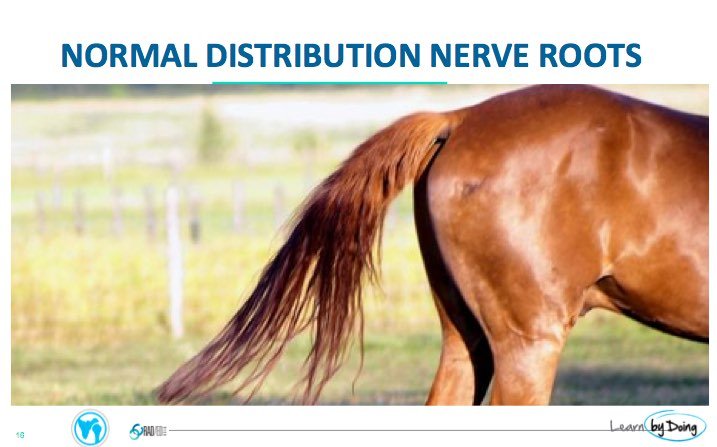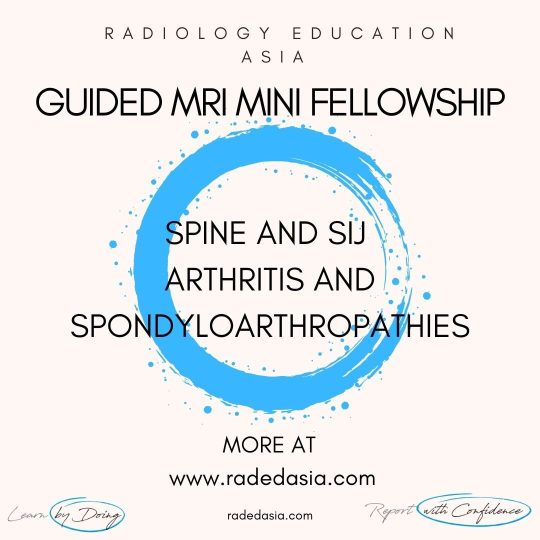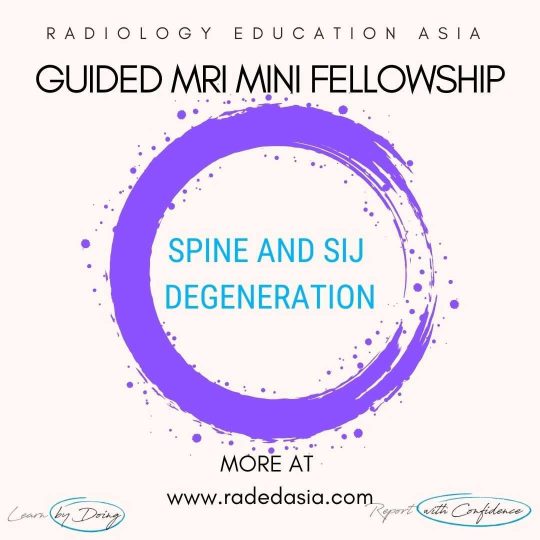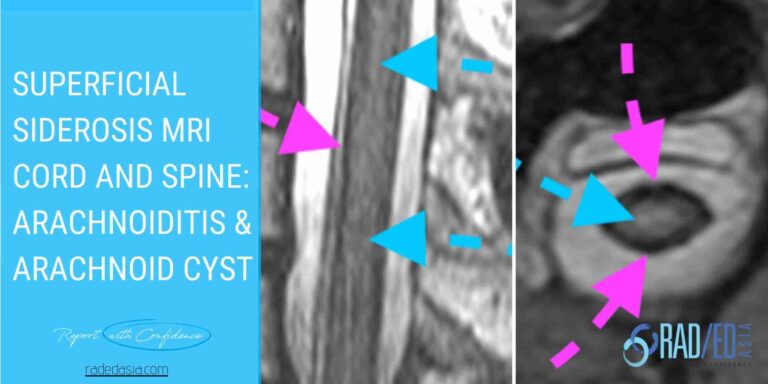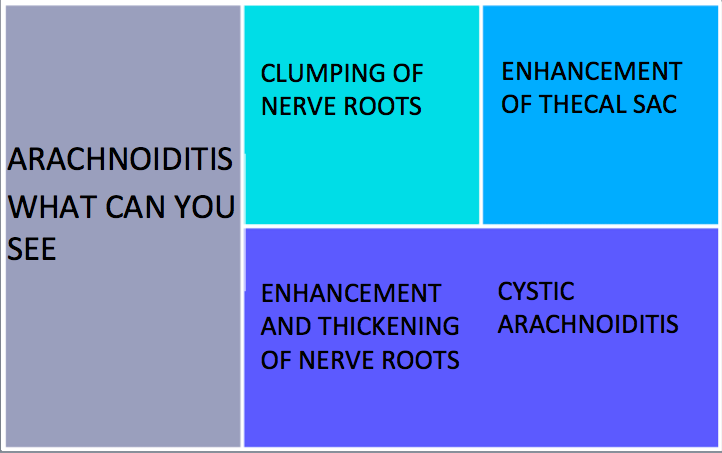
ARACHNOIDITIS PATTERNS ON MRI
what’s the dx?

ARACHNOIDITIS PATTERNS ON MRI
ARACHNOIDITIS PATTERNS ON MRI
Arachnoiditis in the lumbar spine on MRI is not uncommon to see and is easy to diagnose if you know what to look for. In this post we look at What is Normal, Why does Arachnoiditis occur and What to look for.
- Arachnoiditis is not uncommon to see in the lumbar spine. But the most important thing about being able to recognize arachnoiditis is to first know the normal distribution of nerve roots in the spinal canal.
- The normal distribution is a bit like the horse's tail in that more proximally the nerve roots are together and as you go more distally, they separate.

Image Above: The position of the nerve roots depends on what level you are looking at. However it must be symmetrical on both sides whatever level you are looking at.

MECHANISM OF ARACHNOIDITIS:
Arachnoiditis commonly is due to Acute inflammation/infection. Hemorrhagic and chemical arachnoidits can also occur but are less common.
There is a sequence of pathological changes .
• Exudate and fibrin deposited on nerve sheaths and arachnoid.
• Collagen forms.
• Nerve roots stick together.
• Subarachnoid space becomes septated and cystic.

The thecal sac can be affected in two ways.
- Nerve roots stuck to the margins of the sac resulting in a so called empty thecal sac.
- Cystic changes in the thecal sac resulting in Cystic Arachnoiditis.
- Left image demonstrates the normal distribution of nerve roots in the lower lumbar spine.
- The central image demonstrates nerve roots peripherally distributed against the thecal sac margins.
- Right image demonstrates an empty sac where it looks like there are no nerve roots. The nerve roots are present but are flattened against the walls of the sac and are difficult to separate on imaging.

to update
- Normally there is two way flow of CSF between the central canal/ cord and the subarachnoid space and vice versa. Overall net flow is into the cord.
- Arachnoiditis can result in septations, intra dural arachnoid cyst formation and tethering of the cord.
- Cord tethering and septations can result in abnormal CSF flow dynamics with net increase in fluid and interstitial pressure in the cord which can lead to syrinx formation, cord oedema or both.
- Cord oedema and syrinx formation may begin at the level of the septation or cyst but can be extend quite distant to them.

to update
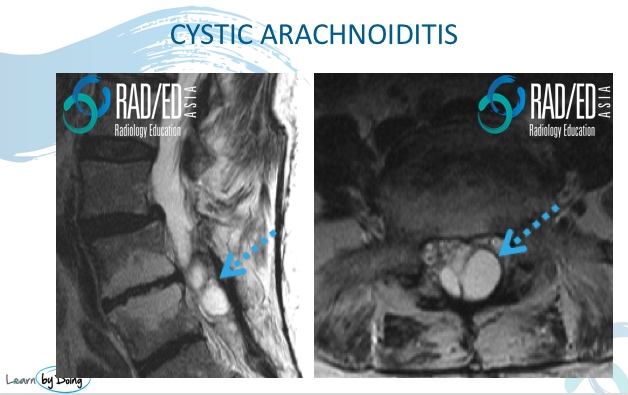
Image Above: Cystic changes and septation in the lumbar thecal sac. Normal distribution of nerve roots not seen.

to update
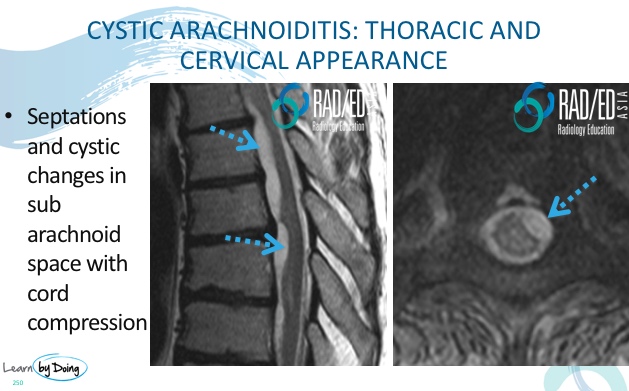
Image Above: Subarachnoid cystic change with cord compression secondary to cystic arachnoiditis.

to update
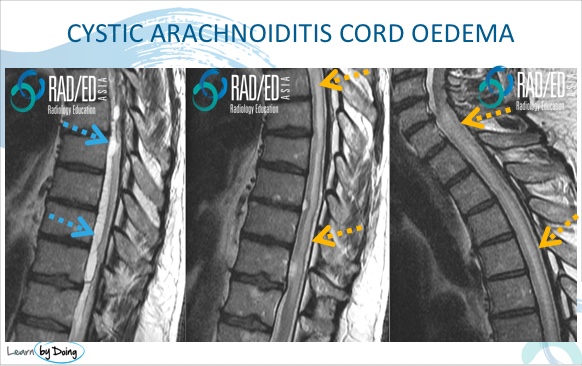
Image Above: Cystic arachnoiditis with cord oedema. Cystic subarachnoid change (blue arrows). Extensive cord oedema (yellow arrows) secondary to altered CSF flow and fluid accumulating in the cord.

We look at all of these topics in more detail in our SPINE MRI Mini Fellowships.
Click on the image below for more information.
- Join our WhatsApp Group for regular educational posts. Message “JOIN GROUP” to +6594882623 (your name and number remain private and cannot be seen by others).
- Get our weekly email with all our educational posts: https://bit.ly/whathappendthisweek
OTHER POPULAR SPINE MRI POSTS: CLICK ON THE IMAGES BELOW
#radiology #radedasia #mri #spinemri #radiologyeducation #radiologycases #radiologist #radiologycme #radiologycpd #medicalimaging #imaging #radcme #rheumatology #arthritis #rheumatologist #orthopaedic #painphysician #chiropractic #chiropracter #physiotherapy #sportsmed #orthopaedic #ankylosingspondylitis #spondyloarthropathy #arachnoiditis #lumbar

